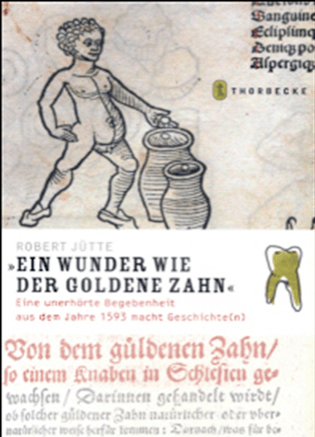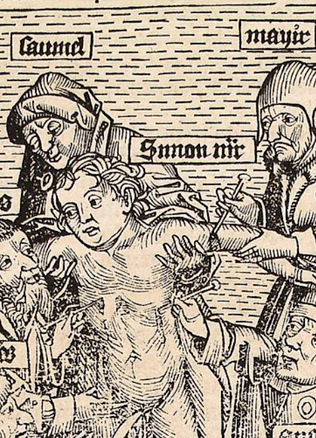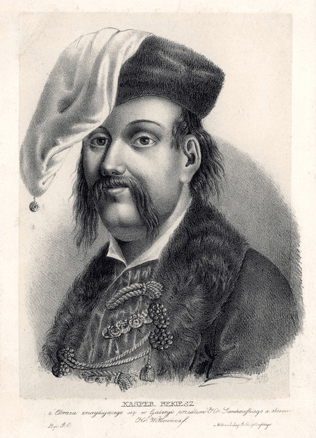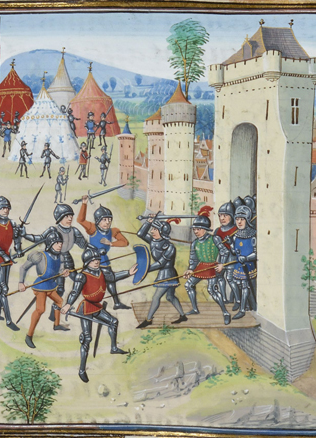Pilėnai and Margiris
Pilėnai is a place that looms in the landscape of Lithuanian history, a place shrouded in legend, a castle that became the symbol of Lithuanians’ life and death struggle for freedom. By hearing the voices of the writers and historians having contributed most to turning Pilėnai into a symbol, we know that Pilėnai duke Margiris and his men fought fearlessly against the numerous forces of the Teutonic Knights. It was only when the situation appeared bleak that they decided to destroy all of the wealth taken to the castle, kill his wives and children, and finally kill themselves. Choosing death instead of slavery, the defenders of Pilėnai showed a special love for freedom. These tragic but noble events occured on February 25th, 1336. The defence of Pilėnai was declared as a typical example of Lithuanians’ valour.
There is no lack of examples of heroic battles with the Lithuanians’ wars against the Teutonic Knights in the 13th and 14th centuries. Some we can mention are the Battle of Saulė (1236), the Battle of Durbė (1260) and the Battle of Aizkraukle (1279). Let’s remember Veliuona Castle that was defended valiantly a number of times, the fierce battles near Kolainiai (1290) and Vaikiai (1322). Or we can read about the battles for Kaunas Castle (1362). These battles are no less fierce, however they do not come close to today’s fame concerning Pilėnai. This happened in part because that there weren’t the kind of horrific killings in them that we see in the battle of Pilėnai: often it happens that a strange event attracts more attention.
Unanswered questions of the drama at Pilėnai
Let’s read some eloquent excerpts from chronicler Wigand of Marburg’s chronicle: “Upon seeing the Christian army, the idolaters became very afraid, losing hope of defending the castle. They threw a heap of the wealth into the fire and killed themselves. They say that there one old female idolater slayed one hundred of them with an axe, and afterwards took her own life.” In describing the battles that raged near the castle, Wigand of Marburg remarked that the duke of Pilėnai (who he calls a “king”) “strove to pay back the Prussians, who hurled fire, trees (logs and firewood) and rocks at the castle and the king. However, the king’s subjects covered him with shields; finally overcome by fear, he escaped to some sort of hole, pierced his wife with a sword and threw her into the flames. The idolaters, stunned by such misfortune, lowered their necks, and all were killed by the king.”
The thing that sticks out the most is that the dramatic event that occurred in Pilėnai speaks little about the Lithuanians’ fight again the Teutonic Knights, but says much about the killings that happened within each camp.
They already arose when the large Teutonic army was just approaching Pilėnai. The fear upon seeing the numerous military forces, which they did not believe they could withstand, is a natural, common reaction. It can be either controlled or not. It appears that in Pilėnai it was not controlled and became killings that occurred among them. Margiris’ behaviour was strange. Despite the brief description, it is clear that Margiris was not able to organise an adequate defence. Instead of inspiring his men to fight on (which one could hope for from a commander), he ran off to the castle’s underground chamber and killed his wife. Then the soldiers became overwhelmed and chose death from the hands of their commander. The only authentic and comprehensive source of the fate of Margiris himself, the chronicle of Wigand of Marburg, says nothing more about him, which is why we can assume that he died (or committed suicide), or perhaps surrendered himself and was taken captive. The ancient Lithuanian historical sources have not recorded a similar event that would show that the general killed his soldiers with his own hands. Strangely enough, this event, which was atypical in many respects, was considered as normal.
Pilėnai as a symbol: writers’ quills and ideologues’ mouthpieces
In order for the story of Pilėnai to become “self-evident,” they needed to use rationalisation and a literary imagination. One of the greatest medieval Polish historians, Jan Długosz, stands as one of the sources of the tradition of reinterpreting the Pilėnai drama. In the 1460s when talking about the battles between the Lithuanians and Teutonic Knights in his The Annals of Jan Długosz, he was the first to give a marvellous account of the active resistance of the Lithuanians against the Teutonic Knights.
As Długosz did not have any other reliable source other than the chronicle of Wigand of Marburg, one should evaluate this innovation as the result of the imagination of a writer and erudite person.
Knowing well the works of historians from Antiquity (first and foremost of Titus Livius), Długosz borrowed some motifs from him and adapted them to his vision of the defence of Pilėnai. In this case, perhaps the most telling examples were the sieges of Astapos (206 B.C.) and Abydos (200 B.C.). It is possible that the common rules about how to depict battles that end in suicide were provided by the story of the Siege of Masada known at the time: in 74 A.D. the Jewish rebels committed suicide in their fortress at Masada after being surrounded by the Romans, not wanting to fall into the hands of the enemy. Similar motifs are reflected in the works, dreams and sermons of later writers. 16th century historians Simon Grunau, Maciej Stryjkowski and Caspar Schütz left their mark in this tradition. They formed the basis that later writers used, certain and convincing their readers that the images they painted of the defence of Pilėnai were factually sound, and correct and meaningful at the level of an idea. Since the things that are correct at the level of ideas are determined by constructs possessing symbolic and administrative power, it is no surprise that in these new times, the image of Pilėnai that has become firmly entrenched in the Lithuanian consciousness has been manipulated both by the authoritative regime of Antanas Smetona as well as the occupying Soviet regime. The latter in particular was concerned with mobilising Lithuanians and showing them and the friendship in war between the Russians and Lithuanias in fighting the West was an ancient historical phenomenon.
There are still Lithuanians today that continue the fight against the Teutonic Knights…
Do You Know?
Medieval Polish historian Jan Długosz was one of the first to exalt the dramatic defence of Pilėnai. As Długosz did not have any other reliable information other than the concise chronicle of Wigand of Marburg that mentioned suicide, one should judge this new piece of information as the result of the imagination of a writer and learned man. It is likely that the common rules about how to depict battles that end in suicide were provided by the story of the Siege of Masada that was known at the time: in 74 A.D. the Jewish rebels committed suicide in their fortress at Masada after being surrounded by the Romans, not wanting to fall into the hands of the enemy.
Literature: D. Baronas, D. Mačiulis, Pilėnai ir Margiris: istorija ir legenda, Vilnius: VDA leidykla, 2010.
Darius Baronas



